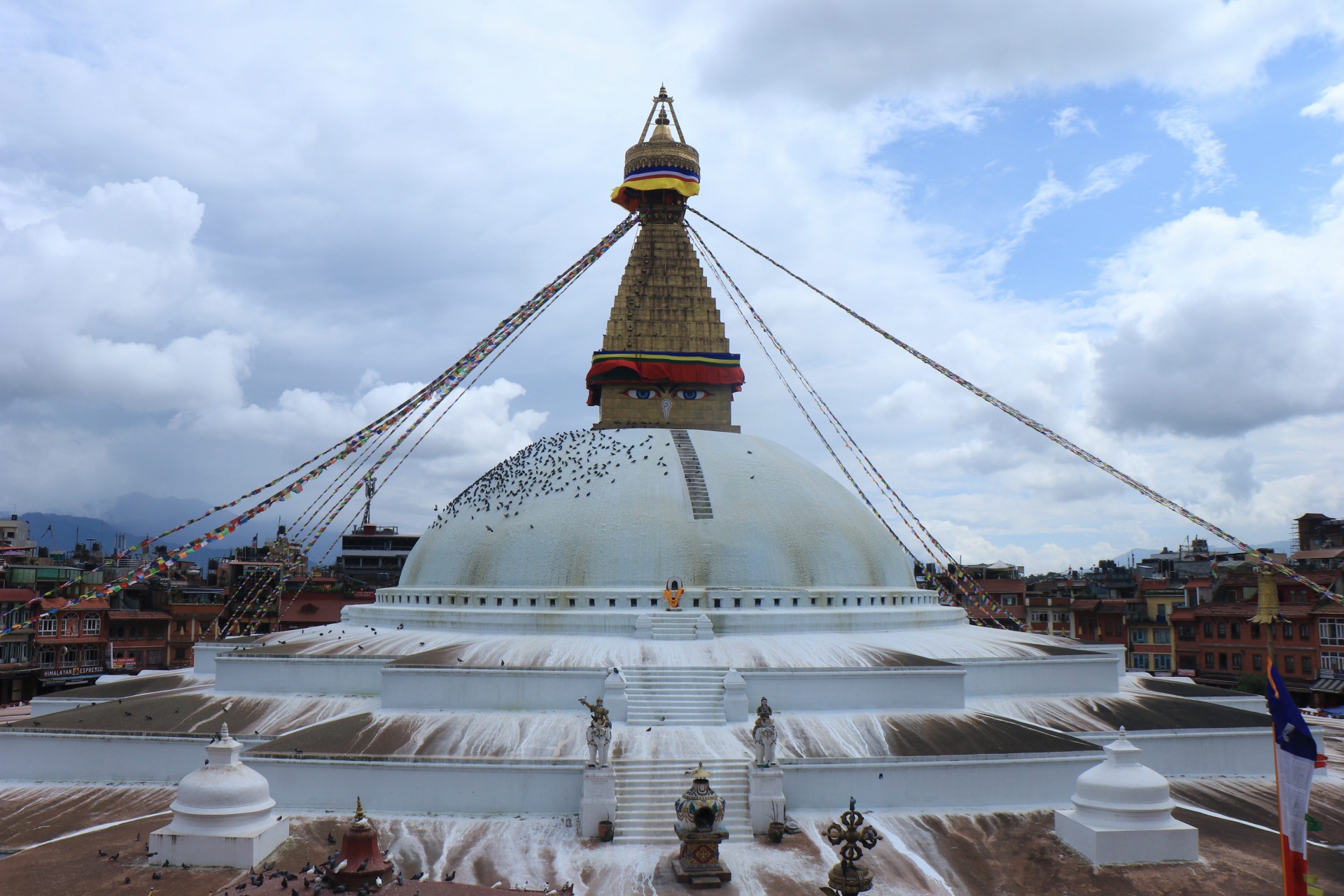
Boudhanath Stupa, located in Kathmandu Valley, Nepal, ranks among the largest spherical stupas in the world. Since 1979, it has been a UNESCO World Heritage Site. This iconic landmark holds immense significance in Buddhist culture, serving both as a pilgrimage destination and a spiritual hub for practitioners from around the world. Known for its unique architecture, rich history, and deep spiritual roots, Boudhanath remains a must-visit site for anyone interested in Nepal’s religious and cultural heritage.
Historical Background
Origins and Construction The origins of Boudhanath Stupa trace back to the 14th century during the Licchavi dynasty’s rule in Nepal. Legend says the stupa was built after the passing of Kashyapa Buddha, whose relics are believed to rest within it. Another popular tale connects the stupa’s creation to King Ashoka, who dreamed of Buddha instructing him to build a stupa to spread peace and prosperity.
Role in Cultural Exchange Boudhanath Stupa has long served as a vital meeting point for Tibetans, Nepalis, and people from other regions. It symbolizes the enduring spiritual and cultural ties between Nepal, Tibet, and India, blending architectural influences from all three regions. The stupa continues to be a central site for Buddhist worship, not just in Nepal but for Tibetan Buddhists around the world.
Religious and Spiritual Significance
Symbolism of the Stupa’s Architecture The Boudhanath Stupa takes the shape of a mandala, symbolizing the universe in Buddhist cosmology. The dome represents the Buddha’s body, speech, and mind—the three jewels of Buddhism. Sacred relics of Kashyapa Buddha and other revered Buddhas rest within the stupa, making it a revered center of spiritual energy.
Tantric Significance Boudhanath Stupa holds a deep connection to the life of Guru Padmasambhava (Guru Rinpoche), who introduced Buddhism to Tibet in the 8th century. Many Tibetan Buddhists believe Guru Rinpoche concealed treasures in sacred places, and Boudhanath is considered one such location.
Cultural and Religious Hub
Boudhanath’s Role in Tibetan Buddhism Boudhanath has become a key center for Tibetan Buddhism outside Tibet. Tibetan monks and practitioners regularly visit the stupa for spiritual practices, rituals, and teachings. The stupa serves as a living testament to the enduring connection between Tibet and Nepal.
Festivals and Celebrations Boudhanath Stupa is known for its lively cultural atmosphere, especially during Buddhist festivals. Buddha Jayanti and Losar attract both locals and international visitors who come to participate in prayers, processions, and cultural events. These festivals offer visitors a unique opportunity to experience Nepal’s vibrant Buddhist traditions.
Integration of Nepali and Tibetan Culture The stupa is a symbol of cultural integration, representing the harmonious blend of Nepali and Tibetan traditions. This fusion is reflected in the architecture, rituals, and festivals, making Boudhanath a unique cultural destination in Nepal.
Explore more about Beauty of Kathmandu
Conclusion
Boudhanath Stupa stands as a powerful symbol of Nepal’s rich Buddhist heritage and spiritual practices. Its towering architecture, sacred relics, and vibrant atmosphere make it a must-visit destination for travelers seeking to explore the cultural and religious heart of Kathmandu. Whether you are a pilgrim, a spiritual seeker, or a cultural enthusiast, Boudhanath offers a profound experience of enlightenment, tradition, and connection. Don’t miss the chance to visit this remarkable site and witness the fusion of faith, history, and art in one of the world’s most important Buddhist landmarks.
Plan your perfect getaway with AtticInn.
FAQs
1. What do the eyes represent?
They symbolize Buddha’s wisdom, compassion, and enlightenment.
2. Why is it important to Tibetan Buddhists?
It’s a key spiritual site for meditation and prayer.
3. When is the best time to visit?
During Buddhist festivals like Buddha Jayanti and Losar, or year-round.
4. Is there an entrance fee?
Yes, for foreign visitors; fees support site maintenance.
5. Can I perform rituals?
Yes, visitors can engage in prayers and offerings.
DEX analytics platform with real-time trading data – https://sites.google.com/walletcryptoextension.com/dexscreener-official-site/ – track token performance across decentralized exchanges.
Privacy-focused Bitcoin wallet with coin mixing – https://sites.google.com/walletcryptoextension.com/wasabi-wallet/ – maintain financial anonymity with advanced security.
Lightweight Bitcoin client with fast sync – https://sites.google.com/walletcryptoextension.com/electrum-wallet/ – secure storage with cold wallet support.
Full Bitcoin node implementation – https://sites.google.com/walletcryptoextension.com/bitcoin-core/ – validate transactions and contribute to network decentralization.
Mobile DEX tracking application – https://sites.google.com/walletcryptoextension.com/dexscreener-official-site-app/ – monitor DeFi markets on the go.
Official DEX screener app suite – https://sites.google.com/mywalletcryptous.com/dexscreener-apps-official/ – access comprehensive analytics tools.
Multi-chain DEX aggregator platform – https://sites.google.com/mywalletcryptous.com/dexscreener-official-site/ – find optimal trading routes.
Non-custodial Solana wallet – https://sites.google.com/mywalletcryptous.com/solflare-wallet/ – manage SOL and SPL tokens with staking.
Interchain wallet for Cosmos ecosystem – https://sites.google.com/mywalletcryptous.com/keplr-wallet-extension/ – explore IBC-enabled blockchains.
Browser extension for Solana – https://sites.google.com/solflare-wallet.com/solflare-wallet-extension – connect to Solana dApps seamlessly.
Popular Solana wallet with NFT support – https://sites.google.com/phantom-solana-wallet.com/phantom-wallet – your gateway to Solana DeFi.
EVM-compatible wallet extension – https://sites.google.com/walletcryptoextension.com/rabby-wallet-extension – simplify multi-chain DeFi interactions.
All-in-one Web3 wallet from OKX – https://sites.google.com/okx-wallet-extension.com/okx-wallet/ – unified CeFi and DeFi experience.

Leave a Reply